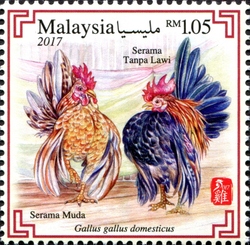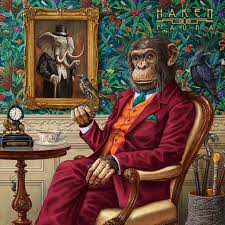Stamp: Malaysian Serama (Malaysia 2017)
Malaysian Serama (Malaysia 2017)
10 January (Malaysia ) within release Malaysian Serama goes into circulation Stamp Malaysian Serama face value 1.05 Malaysian ringgit
| Stamp Malaysian Serama in catalogues | |
|---|---|
| WADP Numbering System - WNS: | WAD:MY003.17 |
Stamp is square format.
Number in set - 5||(show set). Layout - sheet of 20. Issuing - POS Malaysia. Printer - Southern Colour Print New ZealandAlso in the issue Malaysian Serama:
- Stamp - Malaysian Serama face value 0.85;
- Stamp - Malaysian Serama face value 0.95;
- Stamp - Malaysian Serama face value 1.05;
- Stamp - Malaysian Serama face value 3.00;
- Stamp - Malaysian Serama face value 8.00;
- Mini Sheet - Malaysian Serama face value ;
- Mini Sheet - Malaysian Serama face value ;
- Souvenir Sheet - Ayam Serama face value 3;
- Souvenir Sheet - Ayam Serama face value 8;
- Stamp - Serama Bantam (Gallus gallus domesticus) face value 95;
- Stamp - Serama Bantam (Gallus gallus domesticus) face value 1.05;
- Stamp - Serama Bantam (Gallus gallus domesticus) face value 85;
- Stamp - Ayam Serama face value 8;
- Stamp - Ayam Serama face value 3;
|
Data entry completed
83%
|
|
|---|---|
| Stamp Malaysian Serama in digits | |
| Country: | Malaysia |
| Date: | 2017-01-10 |
| Size: | 35 x 35 |
| Perforation: | 14 by 14 |
| Format: | Stamp |
| Face Value: | 1.05 Malaysian ringgit |
Stamp Malaysian Serama it reflects the thematic directions:
Birds (Aves), a subgroup of Reptiles, are the last living examples of Dinosaurs. They are a group of endothermic vertebrates, characterised by feathers, toothless beaked jaws, the laying of hard-shelled eggs, a high metabolic rate, a four-chambered heart, and a strong yet lightweight skeleton. Birds live worldwide and range in size from the 5 cm (2 in) bee hummingbird to the 2.75 m (9 ft) ostrich. They rank as the class of tetrapods with the most living species, at approximately ten thousand, with more than half of these being passerines, sometimes known as perching birds. Birds are the closest living relatives of crocodilians.
Fauna (pl.: faunae or faunas) is all of the animal life present in a particular region or time. The corresponding terms for plants and fungi are flora and funga, respectively. Flora, fauna, funga and other forms of life are collectively referred to as biota. Zoologists and paleontologists use fauna to refer to a typical collection of animals found in a specific time or place, e.g. the "Sonoran Desert fauna" or the "Burgess Shale fauna". Paleontologists sometimes refer to a sequence of faunal stages, which is a series of rocks all containing similar fossils. The study of animals of a particular region is called faunistics.


